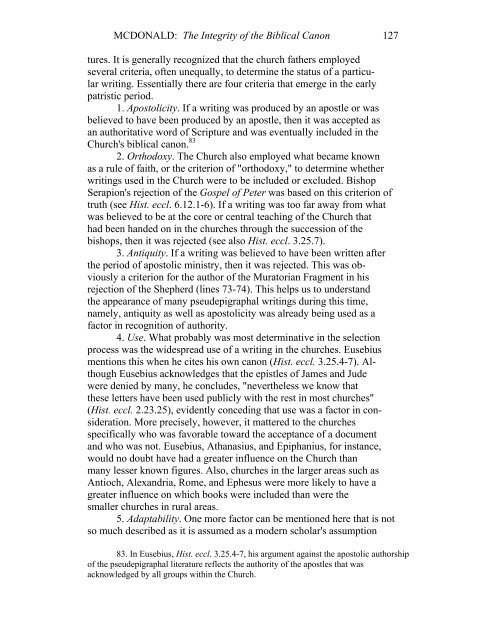The Integrity of the Biblical Canon in Light of Its Historical ...
The Integrity of the Biblical Canon in Light of Its Historical ...
The Integrity of the Biblical Canon in Light of Its Historical ...
You also want an ePaper? Increase the reach of your titles
YUMPU automatically turns print PDFs into web optimized ePapers that Google loves.
MCDONALD: <strong>The</strong> <strong>Integrity</strong> <strong>of</strong> <strong>the</strong> <strong>Biblical</strong> <strong>Canon</strong> 127<br />
tures. It is generally recognized that <strong>the</strong> church fa<strong>the</strong>rs employed<br />
several criteria, <strong>of</strong>ten unequally, to determ<strong>in</strong>e <strong>the</strong> status <strong>of</strong> a particular<br />
writ<strong>in</strong>g. Essentially <strong>the</strong>re are four criteria that emerge <strong>in</strong> <strong>the</strong> early<br />
patristic period.<br />
1. Apostolicity. If a writ<strong>in</strong>g was produced by an apostle or was<br />
believed to have been produced by an apostle, <strong>the</strong>n it was accepted as<br />
an authoritative word <strong>of</strong> Scripture and was eventually <strong>in</strong>cluded <strong>in</strong> <strong>the</strong><br />
Church's biblical canon. 83<br />
2. Orthodoxy. <strong>The</strong> Church also employed what became known<br />
as a rule <strong>of</strong> faith, or <strong>the</strong> criterion <strong>of</strong> "orthodoxy," to determ<strong>in</strong>e whe<strong>the</strong>r<br />
writ<strong>in</strong>gs used <strong>in</strong> <strong>the</strong> Church were to be <strong>in</strong>cluded or excluded. Bishop<br />
Serapion's rejection <strong>of</strong> <strong>the</strong> Gospel <strong>of</strong> Peter was based on this criterion <strong>of</strong><br />
truth (see Hist. eccl. 6.12.1-6). If a writ<strong>in</strong>g was too far away from what<br />
was believed to be at <strong>the</strong> core or central teach<strong>in</strong>g <strong>of</strong> <strong>the</strong> Church that<br />
had been handed on <strong>in</strong> <strong>the</strong> churches through <strong>the</strong> succession <strong>of</strong> <strong>the</strong><br />
bishops, <strong>the</strong>n it was rejected (see also Hist. eccl. 3.25.7).<br />
3. Antiquity. If a writ<strong>in</strong>g was believed to have been written after<br />
<strong>the</strong> period <strong>of</strong> apostolic m<strong>in</strong>istry, <strong>the</strong>n it was rejected. This was obviously<br />
a criterion for <strong>the</strong> author <strong>of</strong> <strong>the</strong> Muratorian Fragment <strong>in</strong> his<br />
rejection <strong>of</strong> <strong>the</strong> Shepherd (l<strong>in</strong>es 73-74). This helps us to understand<br />
<strong>the</strong> appearance <strong>of</strong> many pseudepigraphal writ<strong>in</strong>gs dur<strong>in</strong>g this time,<br />
namely, antiquity as well as apostolicity was already be<strong>in</strong>g used as a<br />
factor <strong>in</strong> recognition <strong>of</strong> authority.<br />
4. Use. What probably was most determ<strong>in</strong>ative <strong>in</strong> <strong>the</strong> selection<br />
process was <strong>the</strong> widespread use <strong>of</strong> a writ<strong>in</strong>g <strong>in</strong> <strong>the</strong> churches. Eusebius<br />
mentions this when he cites his own canon (Hist. eccl. 3.25.4-7). Although<br />
Eusebius acknowledges that <strong>the</strong> epistles <strong>of</strong> James and Jude<br />
were denied by many, he concludes, "never<strong>the</strong>less we know that<br />
<strong>the</strong>se letters have been used publicly with <strong>the</strong> rest <strong>in</strong> most churches"<br />
(Hist. eccl. 2.23.25), evidently conced<strong>in</strong>g that use was a factor <strong>in</strong> consideration.<br />
More precisely, however, it mattered to <strong>the</strong> churches<br />
specifically who was favorable toward <strong>the</strong> acceptance <strong>of</strong> a document<br />
and who was not. Eusebius, Athanasius, and Epiphanius, for <strong>in</strong>stance,<br />
would no doubt have had a greater <strong>in</strong>fluence on <strong>the</strong> Church than<br />
many lesser known figures. Also, churches <strong>in</strong> <strong>the</strong> larger areas such as<br />
Antioch, Alexandria, Rome, and Ephesus were more likely to have a<br />
greater <strong>in</strong>fluence on which books were <strong>in</strong>cluded than were <strong>the</strong><br />
smaller churches <strong>in</strong> rural areas.<br />
5. Adaptability. One more factor can be mentioned here that is not<br />
so much described as it is assumed as a modern scholar's assumption<br />
83. In Eusebius, Hist. eccl. 3.25.4-7, his argument aga<strong>in</strong>st <strong>the</strong> apostolic authorship<br />
<strong>of</strong> <strong>the</strong> pseudepigraphal literature reflects <strong>the</strong> authority <strong>of</strong> <strong>the</strong> apostles that was<br />
acknowledged by all groups with<strong>in</strong> <strong>the</strong> Church.
















